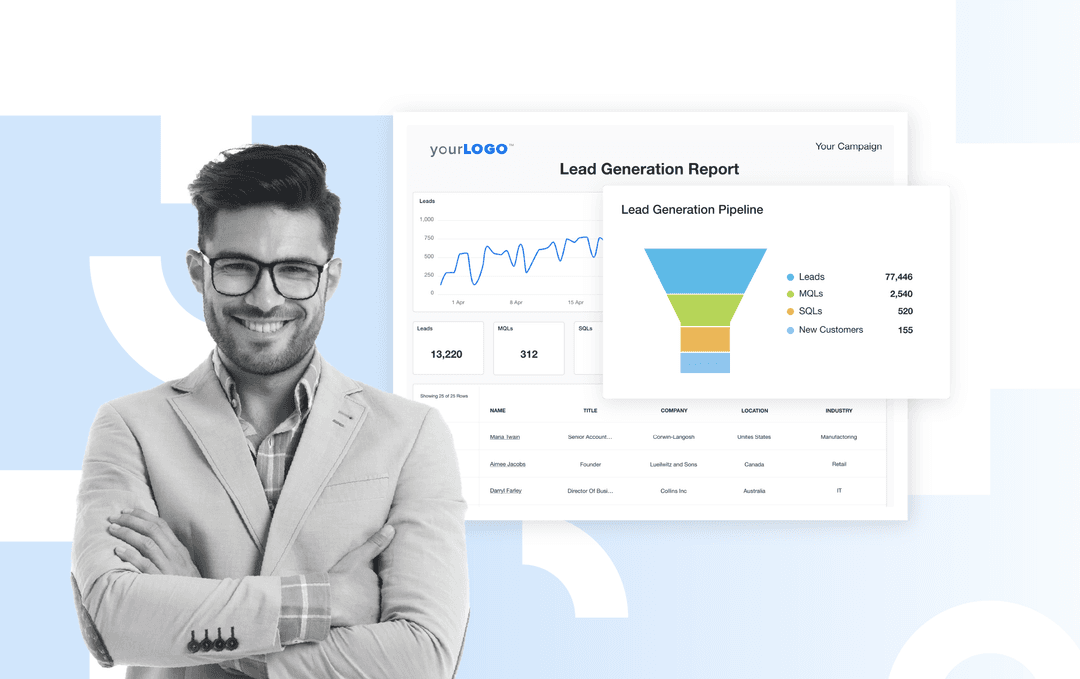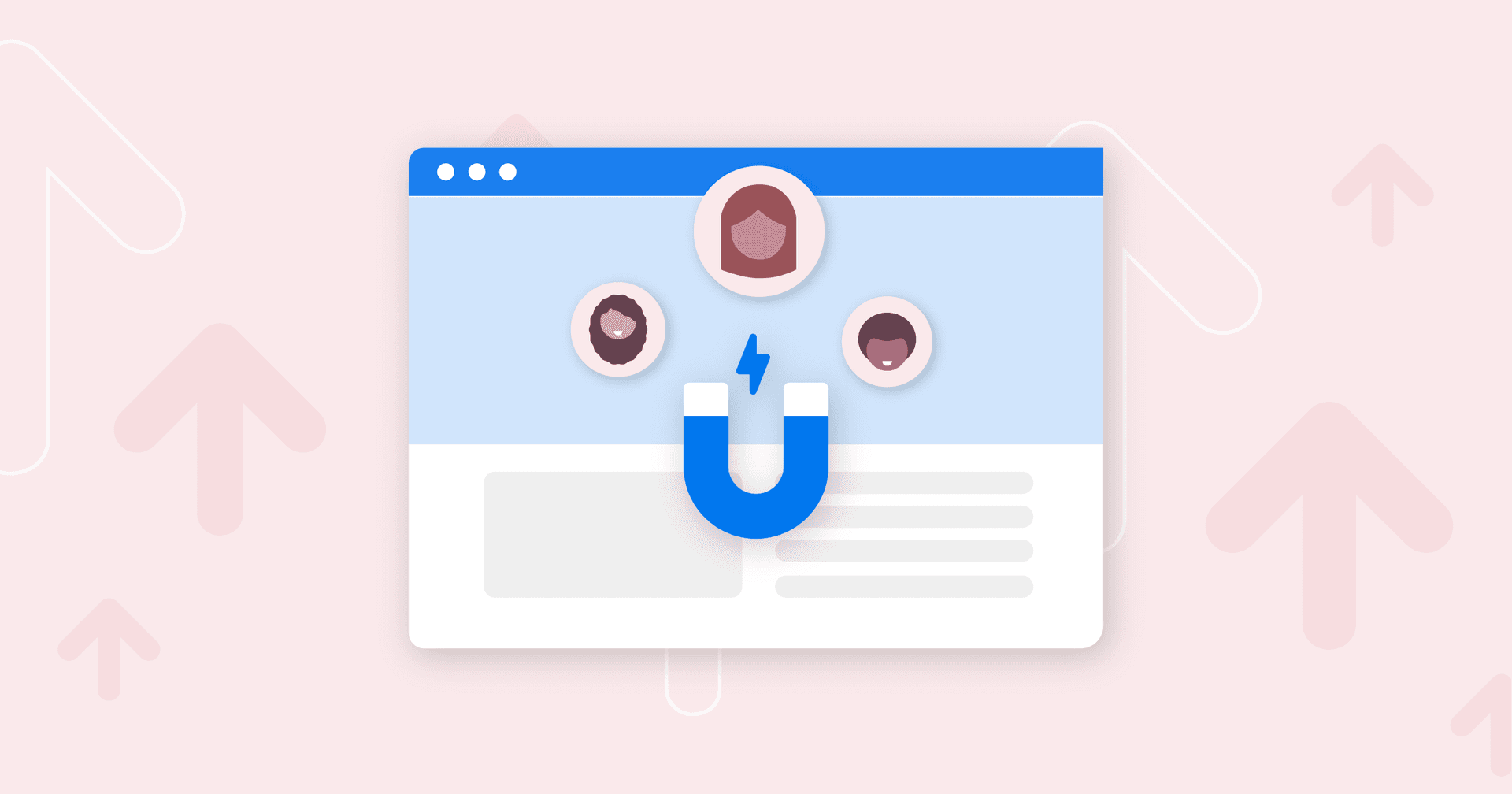Table of Contents
QUICK SUMMARY:
Lead generation KPIs are the key to driving better results in 2025. Use these metrics to measure what matters, refine your agency’s strategy, and deliver clear value to your clients. It all starts with the right KPIs in place, so your agency can optimize every stage of the funnel and boost long-term business growth.
A client’s new campaign is live. You’ve launched the ads, optimized the landing pages, and traffic is flowing. A few days later, your client calls and asks the inevitable: “How’s it going?”
To really prove your agency’s impact, you need to go deeper than simply tracking lead volume. Your team needs to use the right lead generation KPIs to measure what’s working, flag what’s not, and keep your agency-client relationships strong.
In this guide, we’re cutting through the noise and breaking down the 10 most important lead generation KPIs for 2025. You’ll learn what each metric means, why it matters, how to calculate it, and how to use those insights to deliver better results.
We’ll also show you how to track these KPIs across platforms using tools like HubSpot, Salesforce, and CallTrackingMetrics, all without jumping between tabs or exporting spreadsheets.
Ready to simplify your reporting and focus on what really drives growth? Let’s start with the basics.
What Are Lead Generation KPIs?
Lead generation KPIs (key performance indicators) are the metrics that show whether your marketing efforts are actually bringing in potential customers for your clients. These KPIs directly reflect how your agency’s work impacts client growth and how much revenue you’re generating.
These KPIs also act like a performance scorecard by answering important questions, such as:
Are we attracting the right leads?
Are those leads turning into paying customers?
Are we using the budget effectively?
Some KPIs track lead volume, while others highlight lead quality or the cost of acquiring each one. Together, they give a clear picture of campaign performance from start to finish.
When agency leaders use the right KPIs, it’s easier to make smart decisions, show value, and have better conversations with clients.
Now that we’ve covered the basics, let’s look at why these metrics matter so much, especially now.
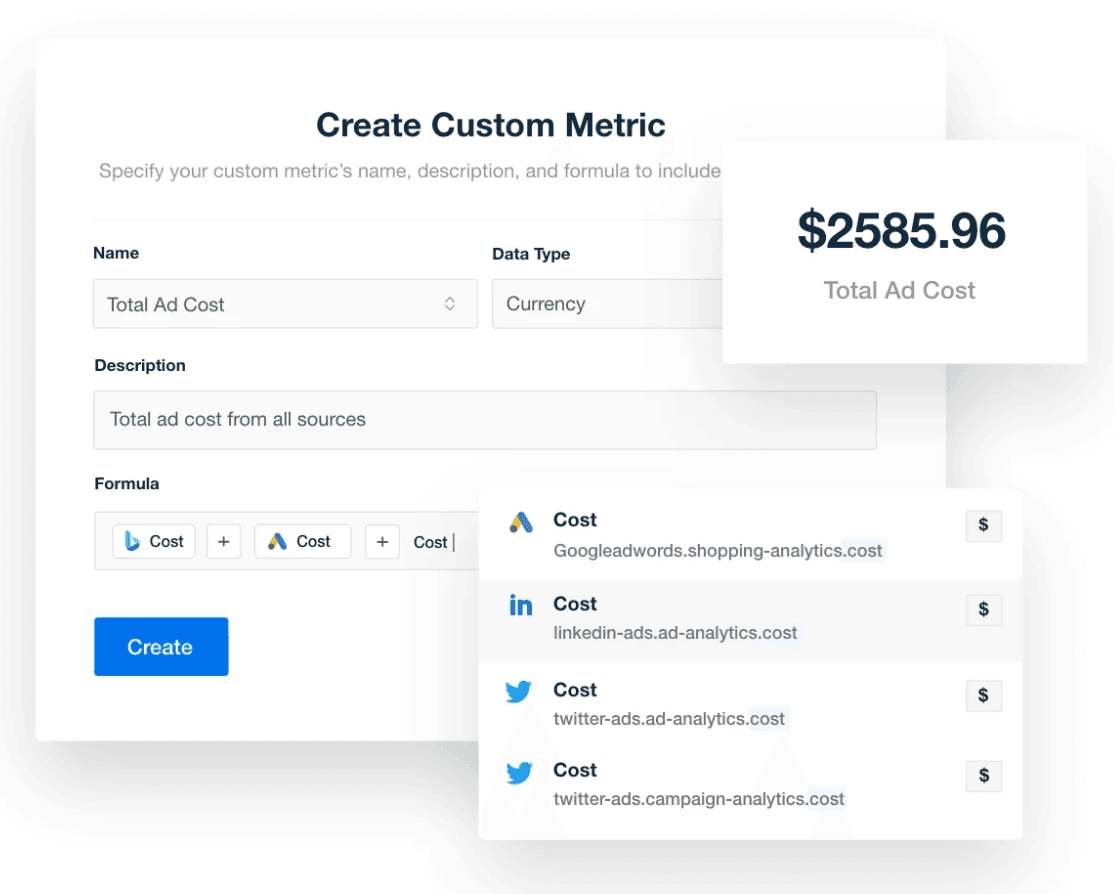
Looking for more flexibility in your reports? Build custom metrics in AgencyAnalytics to highlight exactly what matters to each client. Try it free for 14 days!
Why Lead Generation KPIs Matter
Most agency leaders don’t need to be convinced that their marketing data matters. But when it comes to lead generation, using the wrong metrics (or skipping them entirely) can tank a campaign before it gets off the ground.
Lead generation KPIs give you clarity. They show how well your agency’s strategies are filling the pipeline, where leads drop off, and which campaigns drive real business. Without these metrics, you’re simply guessing. And clients don’t pay agencies to guess.
Tracking the right KPIs helps you:
Prove ROI with a comprehensive lead generation report
Focus on channels that bring in high-quality leads
Optimize campaign budgets in real time
Keep clients looped in with clear, reliable data
However, reporting numbers is only part of the job. The real value comes from using those metrics to tell a clear story. A story that shows clients what’s working, what needs to change, and where the biggest opportunities are. Choosing and tracking the right lead gen KPIs brings that story into focus and strengthens every client strategy.
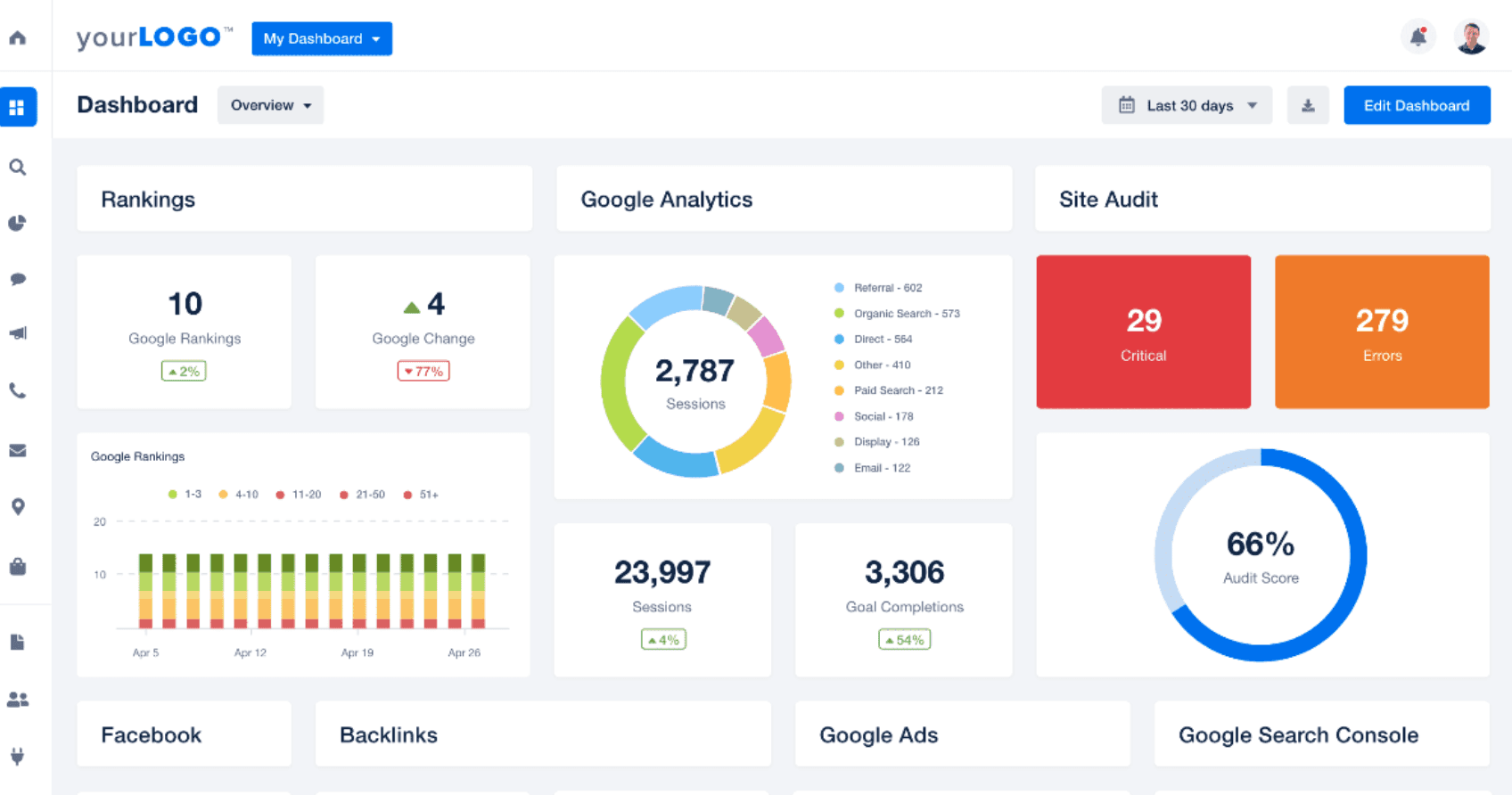
Show clients the whole story behind their leads, without digging through spreadsheets. Use visual widgets to highlight impact and keep them engaged. Start your 14-day free trial of AgencyAnalytics today.
Most Important Lead Generation KPIs To Track
When clients care about growth, lead generation KPIs guide smarter decisions, reveal hidden issues, and highlight exactly where to double down.
Here are the 10 lead gen KPIs that matter most in 2025, along with what they mean, why they matter, and how to use them in client reporting.
1. Number of Leads
This is the baseline metric that keeps everything else in perspective. It shows how many people entered the funnel during a set period.
It’s easy to track, but easy to misinterpret. A spike in lead volume sounds great, until you realize most leads aren’t qualified. On its own, this KPI is a starting point, but not the full story.
Use it to: Spot trends, compare sources, and measure top-of-funnel impact.
Agency Tip: Track it in AgencyAnalytics by integrating with tools like HubSpot or Salesforce to pull lead data into your comprehensive lead generation report.
2. Meetings Booked
Meetings are where intent starts to turn into opportunity. Whether it’s a discovery call, product demo, or strategy session, this metric shows how many leads took the next step.
It’s a clear indicator of lead quality and engagement. More booked meetings usually means better alignment between your targeting and your client’s offer.
Use it to: Evaluate messaging, assess funnel performance, and forecast pipeline growth.
Agency Tip: This helpful article explains the benefits of a data pipeline and how it improves lead generation success.
3. Meetings Attended
Getting on someone’s calendar is one thing. Getting them to actually show up? That’s a stronger sign of buying intent.
Meetings attended helps agencies measure lead engagement quality, not just volume. A high drop-off rate between meetings booked and meetings attended might mean unclear expectations, weak follow-up, or even the wrong type of leads.
Use it to: Refine lead qualification, improve reminder workflows, and spot friction points in the funnel.
4. Engagement
Engagement rate tracks how leads are interacting with your client’s brand, for example, email opens, website visits, time on page, social clicks, or content downloads. It’s an early indicator of interest that often predicts conversion. Instead of guessing which leads are serious, this KPI shows who’s paying attention.
Use it to: Prioritize follow-ups, fine-tune content strategy, and guide nurture campaigns.
Agency Tip: Integrate tools like Instagram Ads, CallRail, or HighLevel to centralize engagement data in your AgencyAnalytics dashboards. This will make it easy to connect the dots across every touchpoint in lead generation campaigns.
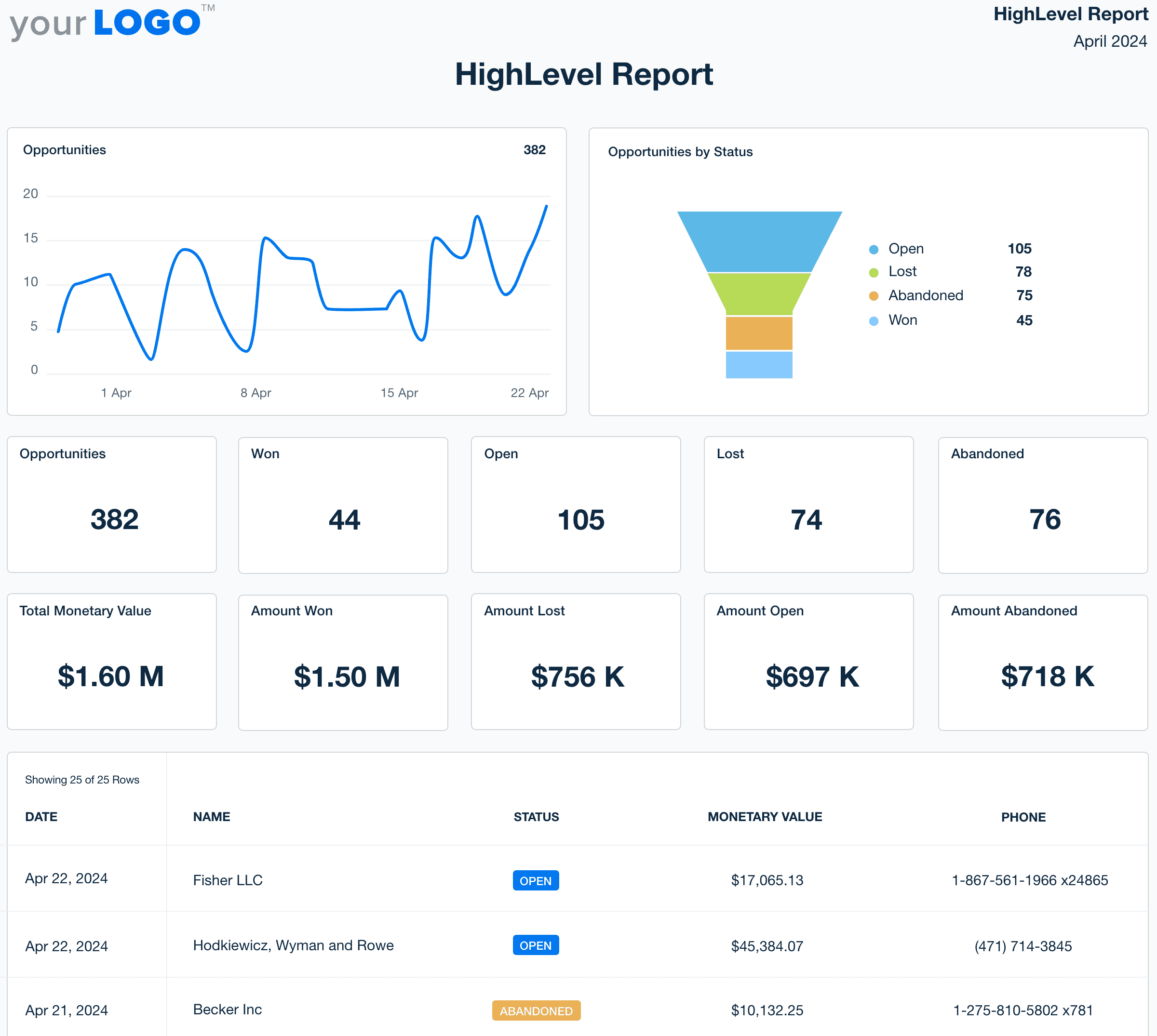
5. Conversion Rate
Conversion rate shows how many leads are taking the desired action: filling out a form, scheduling a call, downloading an asset.
It’s one of the most critical lead generation KPIs because it tells you how effectively your campaigns are turning interest into opportunity. If traffic is high but conversions are low, it’s time to revisit your targeting, offer, or landing page experience.
Use it to: Improve campaign performance, test creative assets, and justify ad spend by tracking lead conversion rate.

Easily track lead conversion rates in a dedicated Google Analytics dashboard. Create one in minutes using AgencyAnalytics. Get started today with your 14-day free trial!
6. Marketing Qualified Leads (MQLs)
Marketing Qualified Leads meet specific criteria, suggesting they’re more likely to become customers. This KPI helps agencies move beyond vanity metrics and focus on prospects who are ready for a sales conversation.
The exact definition of an MQL varies by client, so agree on those criteria up front. It could be based on engagement level, company size, job title, or actions taken.
Use it to: Clients will always want more qualified leads. Use this metric to align marketing with sales, focus on high-potential leads, and avoid wasting time on unqualified traffic.
7. Sales Qualified Leads (SQLs)
Sales Qualified Leads are leads that the sales team has reviewed and marked as ready to pursue. This KPI shows how well your lead gen campaigns are fueling real pipeline activity.
Tracking the handoff between marketing and sales is critical here. A gap between MQLs and SQLs might signal weak lead quality, unclear criteria, or poor follow-through.
Use it to: Improve collaboration with sales teams and fine-tune targeting.
8. Total Lead Value
This KPI assigns a dollar value to the leads generated within a time frame. It helps clients understand the potential revenue impact of your lead generation efforts, which is especially useful when proving ROI.
Agencies calculate this based on average deal size, close rate, and the number of qualified leads.
Use it to: Forecast revenue, prioritize campaigns, and show clients the value of top-funnel activity.
9. Cost Per Lead (CPL)
CPL measures the cost of generating a single lead. It’s essential for budgeting, evaluating performance across channels, and controlling acquisition costs.
A low CPL isn’t always better. If cheaper leads aren’t converting, you’re wasting budget. That’s why it should always be tracked alongside quality-focused metrics like MQLs or meetings booked.
Use it to: Allocate spend wisely, compare channel efficiency, and spot overspending early.
10. Cost Per Meeting
This KPI further narrows the lens by tracking how much you spend to engage someone in a real conversation. It’s especially important for agencies working on appointment-setting campaigns or selling higher-ticket offers.
Cost per meeting gives you a clear link between spend and pipeline movement. It’s where strategy, messaging, and lead quality all show up on one line.
Use it to: Fine-tune outreach, measure campaign efficiency, and report on deeper funnel impact.
11. Customer Acquisition Cost (CAC)
Customer Acquisition Cost shows how much your client is willing to spend to acquire a single customer. It includes the total cost of sales and marketing divided by the number of new customers over a given period.
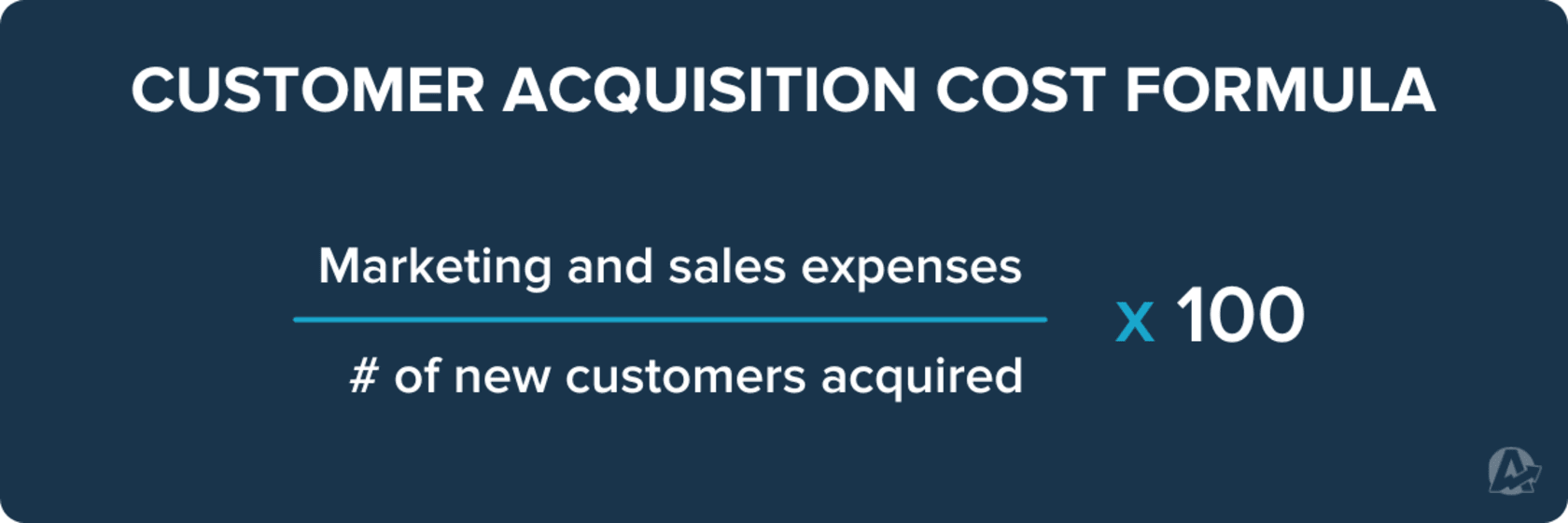
This KPI helps clients understand how efficiently their marketing dollars are working. High CAC might signal wasted budget or poor targeting, while a lower CAC paired with quality customers shows strong campaign performance.
Use it to: Evaluate campaign ROI, optimize spend, and benchmark efficiency over time.
12. Monthly Recurring Revenue (MRR)
MRR tracks predictable revenue generated from active subscriptions or retainers on a monthly basis. It’s especially useful for SaaS and service-based businesses.
For lead gen campaigns, MRR links your efforts directly to bottom-line growth. If you’re driving leads that convert into long-term paying customers, this number will reflect that impact.
Use it to: Measure long-term value, forecast growth, and connect lead gen to revenue performance.
13. Customer Lifetime Value (CLV)
CLV estimates the total revenue a customer will bring in over the course of their relationship with the business. When paired with CAC, it gives a full picture of profitability.
This KPI is powerful for understanding the long-term impact of lead generation. Not all leads are equal—some convert fast but churn quickly, while others stick around and drive consistent revenue.
Use it to: Guide targeting strategy, prioritize high-value leads, and align campaigns with long-term growth.
How To Choose the Right Lead Gen KPIs
Tracking everything is tempting. And sometimes it’s difficult to draw the line between useful and excessive.
Keep this in mind when you’re building a client report: More data doesn’t always lead to better insights. Let us explain.
Some of the smartest agencies focus on key performance indicators that align directly with each client’s goals, sales process, and offer. For example, a local service business booking consultations will care more about meetings attended. On the other hand, a B2B SaaS company might prioritize MQLs, lead generation metrics, and total lead value.
Here’s how to choose the right mix:
Start With the Goal: What’s the client trying to achieve? More volume, better quality, higher close rates?
Match KPIs to Funnel Stages: The right lead generation metrics should reflect the sales funnel, with different indicators for top-of-funnel awareness versus sales-ready leads.
Use SMART KPIs to Stay Focused: That means specific, measurable, achievable, relevant, and time-bound. (Here’s a full guide on using SMART KPIs.)
Balance volume and value: Don’t fall into the trap of chasing lead counts without considering quality, customer lifetime value, or ROI.
When sales and marketing teams agree on which KPIs matter most, your agency becomes the bridge that drives alignment, strategy, and results. That’s how reporting goes from a monthly chore to a critical part of managing a client’s marketing budget.
In the next section, we’ll show you how to track these KPIs for lead generation seamlessly in AgencyAnalytics, so you keep every client on track without adding to your workload.
How To Track Lead Generation KPIs in AgencyAnalytics
Tracking lead gen KPIs doesn’t need to eat up hours of your week or require bouncing between platforms. With AgencyAnalytics, you get everything in one place. This means your reporting platform is fully automated, fully visual, and built specifically for agencies.
Here’s how to set it up:
Step 1: Connect Your Lead Sources
Integrate with lead generating platforms like Klaviyo, Shopify, WhatConverts, or any other platform your clients use. Data flows directly from those lead generation channels into your clients' marketing dashboards; there are no disconnected data spreadsheets involved.
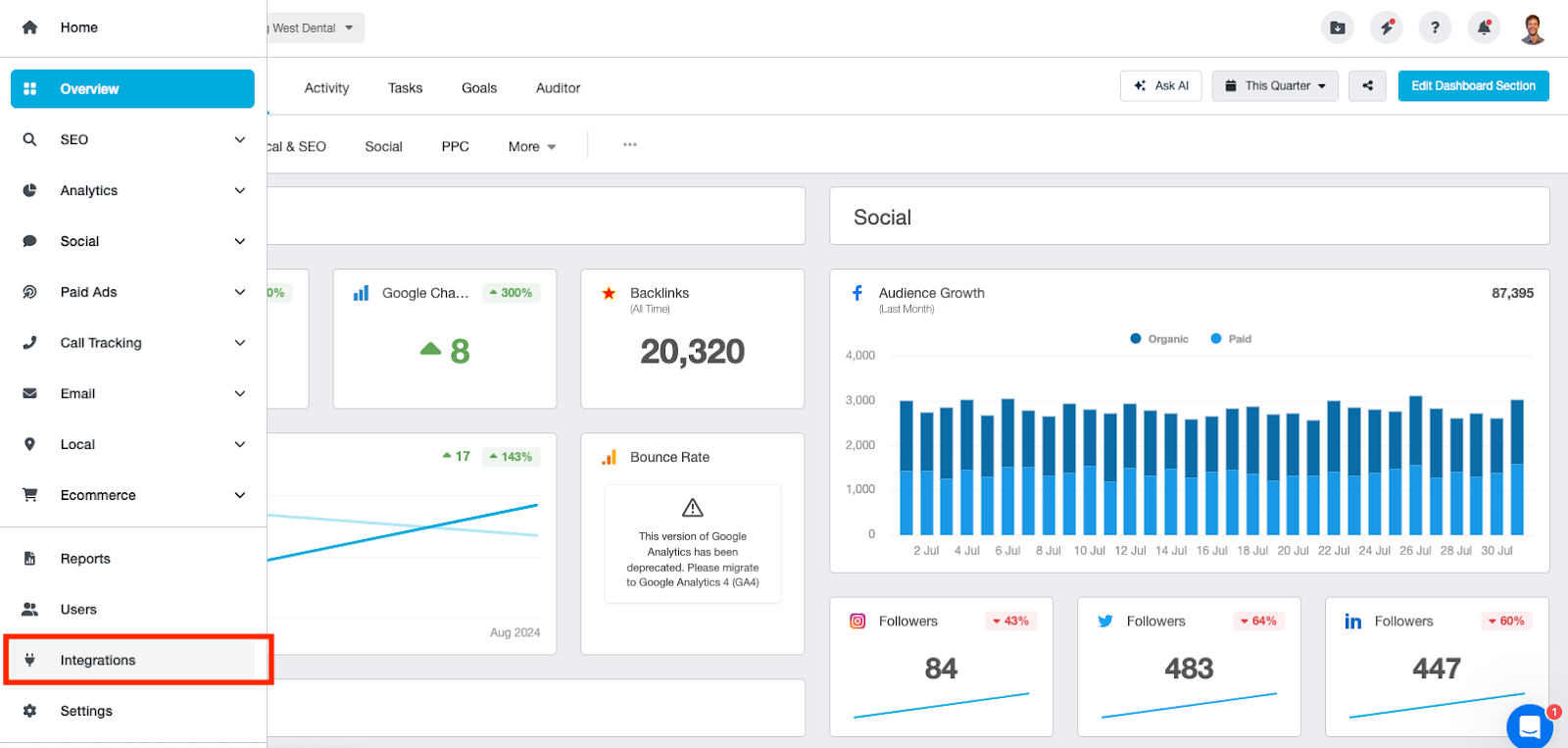
Step 2: Build Dashboards in Minutes
Use drag-and-drop widgets to create client-facing dashboards that highlight KPIs like MQLs, conversion rate, and cost per lead. Customize views for each client so they see what matters most.
Agency Tip: Try the Smart Reports feature to speed up the reporting process. Simply choose the marketing platform you need to report on and AgencyAnalytics will automatically populate the top metrics into a ready-made report (with the option to customize).

Step 3: Automate Your Reporting
Set up scheduled reports that pull real-time data from your clients’ marketing campaigns. No more scrambling before client calls. Your updates on new leads, lead cost, and sales pipeline activity are always ready and up to date.
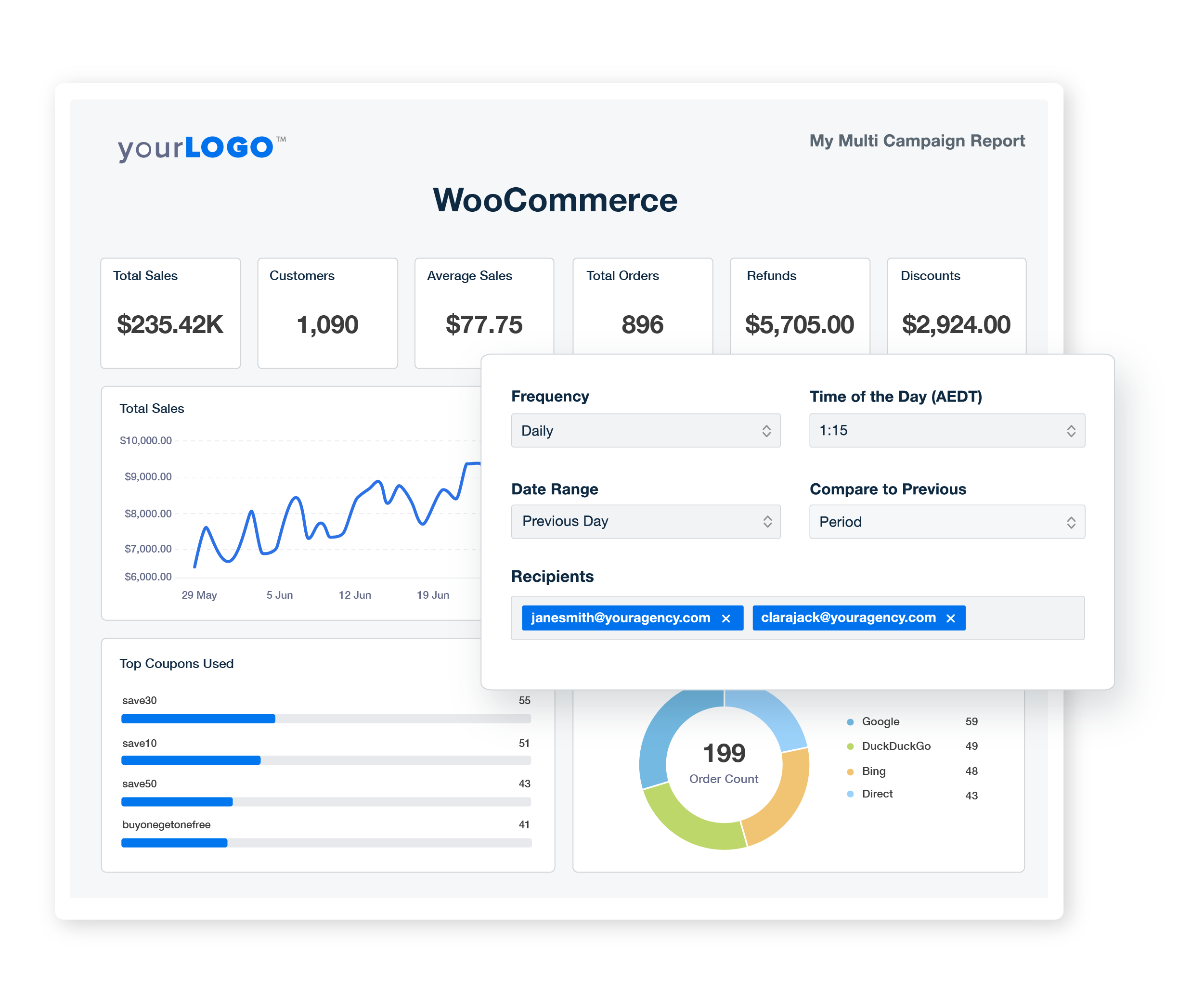
Step 4: Drill Down Into Performance
Want to know which campaigns brought in the most SQLs or which source has the lowest cost per meeting? All that detail is available at a glance.
Or maybe you need a step-by-step on how to track KPIs effectively? We’ve got that covered, too.
AgencyAnalytics makes it easy to focus on strategy while staying fully transparent with your clients.
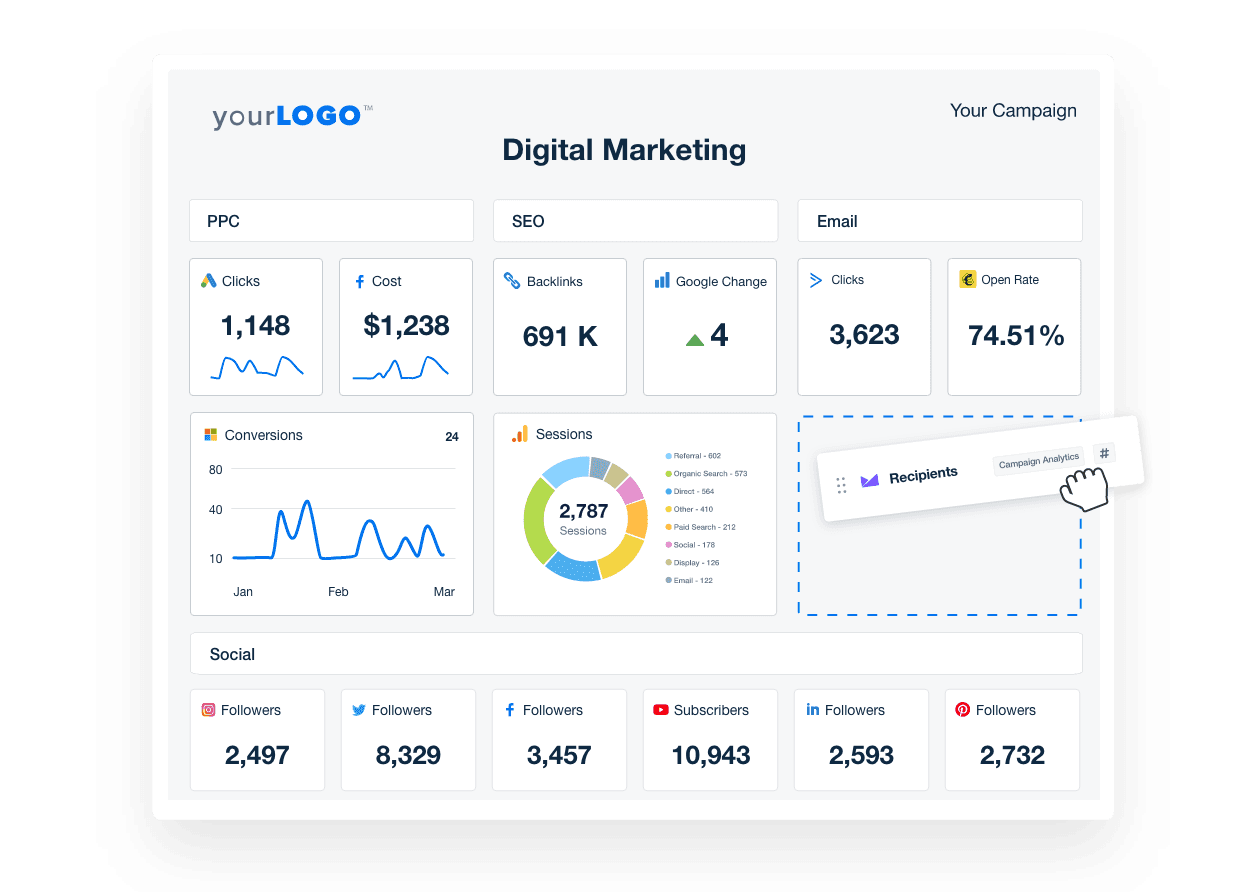
Track all of your client’s important metrics in one, easy-to-read client dashboard. AgencyAnalytics pulls from over 80 marketing platforms so you don’t have to jump around looking for metrics. Try AgencyAnalytics free for 14 days!
Final Thoughts
Tracking lead generation KPIs the right way changes everything. When you measure lead generation effectively, you gain clarity on your marketing and sales efforts. Your agency is showing the connection between strategy and outcomes, whether that’s in the number of new leads, the revenue generated, or the conversion rate across sales efforts.
Remember, the most successful lead generation strategies are built around relevant, specific data. That includes tracking important lead generation metrics like cost per lead, average revenue generated, and the volume and quality of leads moving through the funnel. These numbers shape decisions, justify marketing spend, and improve client retention.
For agency leaders, the value comes from connecting each key lead generation KPI to business outcomes. Let’s say you're generating interest at the top of the funnel or perhaps pushing qualified leads through to the sales team; either way, your lead gen strategy has to deliver measurable results across all sales and marketing campaigns.
With AgencyAnalytics, you get the tools to do just that. From visual dashboards to scheduled reports and customizable metrics, it's built to help agencies measure lead generation results clearly and consistently.
Show clients the full story behind their leads. It’s easy with AgencyAnalytics! Sign up for your free 14-day trial today!

Written by
Richelle Peace is a writer with a degree in Journalism who focuses on web content, blog posts, and social media. She enjoys learning about different topics and sharing that knowledge with others. When she isn’t writing, Richelle spends time teaching yoga, where she combines mindfulness, movement, and her passion for wellness.
Read more posts by Richelle PeaceSee how 7,000+ marketing agencies help clients win
Free 14-day trial. No credit card required.


